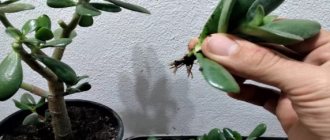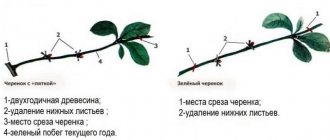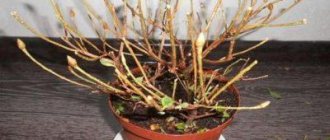What time of year is best to propagate?
Planting a cactus shoot can be done throughout the year , but still the best time is spring and summer.
The fact is that the birthplace of succulents are countries with hot climates. The temperature regime and daylight hours during spring and summer are close to the “native” weather conditions of this flower. In addition, any plant in warm weather experiences a phase of active vegetative development, which will greatly facilitate the process of rooting the succulent. In late autumn and winter, you can also try to plant a baby adult cactus, but you must remember that the young plant will need additional care: providing enough light, observing the temperature regime.
Selection and preparation of land for planting
Priming
Ordinary garden soil is not suitable for rooting and growing cactus. A special substrate for succulents can be purchased at a flower shop, the main components of which will be river sand, humus from leaves and turf, peat and all the necessary nutrients.
If it is not possible to purchase this mixture, you can prepare it yourself:
- coarse river sand, garden soil, peat mixed in a ratio of 1:1:0.5;
- you can add some crushed dry leaves and foam balls.
Drainage
A necessary component of the internal filling of the pot, in which a cactus without roots will be planted, is drainage - a layer of certain materials that helps drain excess water when watering. The drainage volume should occupy a maximum of 1/5 and a minimum of ½ of the container. Drainage may consist of :
- expanded clay;
- pebbles;
- small pebbles;
- broken bricks;
- broken foam;
- pre-cut wine corks.
Methods and rules of vegetative propagation
Vegetative propagation of cacti involves the use of “babies” and cuttings obtained from strong, healthy plants. These methods are among the simplest, so even a novice gardener can use them.
"Kids"
This method of growing cacti can be used all year round. However, it is best to propagate plants as “children” in the spring and summer. If it becomes necessary to grow a young cactus from a shoot in the fall or winter, the plant should be provided with sufficient lighting and optimal temperature and humidity conditions.
To grow “babies”, use a special substrate for succulents or a soil mixture prepared from the following ingredients:
- fertile and loose garden soil - 1 part;
- clean coarse sand – 1 part;
- peat – 0.5 parts.
Crushed charcoal and/or small fractions of polystyrene foam are added to this mixture as drainage elements. Drainage should also be poured into the bottom of the container in which the shoot will be grown. Crushed expanded clay, brick chips or pebbles can be used here as drainage.
A convenient plastic container of sufficient width and depth is suitable for growing cacti. Considering that these plants have a very developed root system, shallow and small containers are not suitable for them. Holes must be made at the bottom of the selected container to drain water.
Having prepared everything you need, you should carefully examine the donor plant and carefully separate the largest and strongest shoots from it. In most types of cacti, the “babies” already have root primordia at the time of separation, so detaching them from the donor plant is not difficult
In some cases, when the “baby” has no roots and is tightly attached to the mother plant, it is cut off with a sharp blade. After this, the cut area is treated with activated carbon powder, and the shoot itself is placed in a dark place for a couple of days. When the cut site dries out a little, begin planting the shoot.
Before planting, make a shallow hole in the surface of the substrate and place the “baby” there, cut side down. In this case, there is no need to dig in a shoot without roots.
If the “baby” has rudiments of roots, they are carefully straightened with a thin stick, the roots are lightly sprinkled with sand or vermiculite, and the soil is carefully pressed down, fixing the shoot in a stable position. You should not cover the roots too much, otherwise they will not be able to fully develop.
After transplantation, the container with the “babies” should be removed for 2–3 days in a dark place. It is recommended that the first watering of established shoots be done no earlier than after 5–7 days.
The fact that the “baby” feels good after the transplant will be evidenced by her healthy appearance and gradual growth.
Cuttings
Types of cacti that do not form shoots are propagated by cuttings. Only healthy and well-developed specimens are suitable for this method.
In this case, you can get a viable cutting by cutting off the top. Cutting is carried out with a tool with a sharp blade, pre-treated with any alcohol-containing product. The cut site on the plant and cuttings is also disinfected. In addition, the cut of the cutting is additionally treated with a solution of a root formation stimulator.
After pruning, you cannot immediately plant the cuttings in the substrate. After treating the planting material with disinfectants and stimulants, it is removed for several (5–6) days in a dry and dark place, fixed in a vertical position. This procedure is necessary so that the cut area can dry out a little. This is an important condition for the prevention of rot.
Planting the cuttings is done in the same way as planting “babies”, lightly sprinkling the lower part. Cuttings that are too long are fixed on a wooden or plastic support. To root the apical part of the cactus, use the same composition of the substrate as in the case of planting shoots.
Selecting and preparing a pot
Material
Many gardeners advise planting succulents in plastic containers , since plastic is a substance that does not absorb water and does not change the temperature of the soil placed in the pot.
Lovers of everything environmentally friendly can easily plant a succulent in a container made of clay or ceramics.
It is better if the pot is light in color so that the soil in it heats up less.
Size
Cacti grow in arid climates, so they have a long root system . Therefore, when choosing dishes, it is necessary to take into account the fact that its root system needs space, which means that cramped and small dishes will not be suitable for planting. Preference should be given to wide and deep dishes, in which the roots of the plant will feel free and will receive a sufficient amount of moisture and nutrients.
The main condition that a cactus pot must meet is the presence of drainage holes to drain excess water. Otherwise, the liquid accumulating at the bottom will cause the roots of the succulent to rot and, consequently, lead to its death.
Features of cacti as plants
These representatives of the flora belong to succulent plants. That is, they are able to accumulate moisture in their powerful stem. Unlike other green organisms, they do not have leaves. The shoots are covered with hard or soft spines involved in photosynthesis.
The Cactus family is numerous, with over 2 thousand species, which are combined into 300 genera. America is considered the birthplace and main place of growth. Mexico, Chile, Argentina, Sri Lanka are rich in various species. They grow in arid desert areas and tropical jungles. Succulents survive in extreme conditions.
The trunk, also called the body, can grow to enormous sizes in the wild. The height of the stems sometimes reaches 10 m. The highest height recorded by scientists was 19 m.
The shoots grow very slowly, the annual growth is usually small. Along with giant succulents, there are also miniature specimens. The diameter of the Blossfeldia cactus reaches 1 cm.
Thorns are needed not only for protection from predatory animals, but also for protection from the sun. No matter how thick the spines are, they cast a shadow on the trunk. The thicker the layer the shoots are covered, the higher the preparedness for the scorching sun.
The skin is dense, practically impermeable to gases and liquids. Pubescence often plays the role of an absorbent sponge.
Another interesting feature of most species is that the thorny bushes do not form inflorescences; the flowers do not have a peduncle. The flower acts as a continuation of the stem. With excess feeding, some growing buds change into babies.
Flowering for these representatives of the flora is an unstable phenomenon. Some specimens bloom annually, others very rarely and only under very favorable conditions.
Some varieties are covered with flowers all over the top, creating a cap. The duration of flowering also varies. While some specimens have flowers that last for several weeks, others may close after a few hours.
Depending on the species, plants take on different shapes. The trunks are wrinkled, with ribs and tubercles. The ribs can be pronounced or barely noticeable, smooth or spiral-shaped. Plants are covered with different spines: dense, sparse, long, short, soft or hard.
A person needs to be careful with thorns. The needles can prick, and in some species they are a source of poison.
How to properly take a shoot with roots, what to pay attention to?
Before planting a shoot, you need to select and prepare it. “Children” are formed on the cactus itself in the process of its life . They can be located either on the top of the plant or at the bottom, at the very roots, it all depends on the type of succulent. Separating them from the mother plant is not difficult, because they are minimally connected to the stem. While still on an adult cactus, the shoots of most types of succulents begin to produce roots. In addition, over time, the shoots can fall off and, falling to the ground, begin to develop their root system, so reproduction occurs without problems.
When choosing a shoot for transplantation, it is important to pay attention to its size (a large one is stronger and more viable), its location (it is believed that high-quality shoots grow closer to the top of the plant).
also propagate cactus with “babies” that do not have roots - this will not cause any particular difficulties. In any case, the shoot is placed on a clean, dry sheet of paper and placed for 3 days or 1 week in a dark and cool place to slightly dry the cut site (this is done to prevent rotting of the shoot). Read more about all the ways to plant a cactus without roots in this article.
Types of cacti
Let's look at this in more detail. The most popular types of cacti, photos and names of which can be found on resources of interest:
- Astrophytum: grows quite well. A distinctive feature of the culture is the presence of white flakes on the outside of the ribs. When flowering, beautiful yellow inflorescences are formed.
- Ferocactus: has hard, long spines. Usually this type of cacti has a cylindrical shape. It can reach 5-6 inches in height. “Children” often appear near the main trunk. In summer, large flowers may appear on adult specimens.
- Prickly pear: this type of cacti is characterized by its unpretentiousness and rapid growth. It is important to use gloves when caring for this plant, as it has very sharp spines. The peculiarity of this cactus is the presence of tiny, spiny bristles throughout the stem. They can cause much more inconvenience than the needles themselves, since they are very difficult to notice. There are different varieties of prickly pear: flat, oval, and so on. These cacti are characterized by their large size. They bloom unusually spectacularly. They bear edible pear-shaped fruits. The plants are quite hardy and can be planted even in open ground.
- Echinocereus: small spherical cacti covered with short spines. They bloom quite often with beautiful inflorescences. Caring for this type of cacti is very easy, so it is often recommended for beginners.
Photo
In the photo you can see a cactus with “babies”:
Step-by-step instructions: how to plant a flower and a shoot with or without roots?
Let's take a closer look at how to transplant shoots without roots or with roots from an adult plant .
- Separate the shoots from the mother plant with a sharp knife or tweezers.
Despite the fact that the “babies” are not firmly attached to the mother plant, the shoots must still be separated very carefully: if the slightest particle of the “babies” remains on the cactus, the plant may rot and the sprout will not take root. - Prepare everything you need for planting: pot, soil, drainage, withered shoots, spatula.
- Place a drainage layer on the bottom of the pot.
- Cover the rest of the container with soil, which must be moistened.
- You need to make a small depression in the center of the pot.
- Place the “baby” cactus in the recess, cut side down, without digging in. If the “baby” has roots, then after placing them in the recess they must be carefully straightened.
- You need to lightly press the ground with your hands in order to fix the shoot in one position. You can’t bury it too deep!
To prevent intense evaporation of moisture from the soil surface, small pebbles or sea pebbles can be placed on top .
Vegetative propagation: how to propagate cacti by children and cuttings
Vegetative propagation of cacti - by cuttings or layering - is easier to do. Some species have evolutionary adaptations for such reproduction - side shoots that are easily separated from the mother plant - children, often equipped with tenacious spines. In nature, prickly babies, like burdock fruits, are spread by animals (in general, in nature, vegetative propagation among cacti is quite widespread). Usually the junction of the baby with the mother stem is very narrow and already at an early age is equipped with rudimentary roots. When cacti are propagated by children, rooting is not a problem - just place the baby on any moist substrate, and its root system will quickly develop. The plant grown from the baby is practically no different from the mother plant. But before you propagate a cactus with children, keep in mind that this method, used for a long time, leads to a decrease in the quality of the plants and at least periodic renewal from seeds is necessary to maintain the normal species in the culture.
The situation is more complicated with the vegetative propagation of cacti that do not produce children. Fast-growing species (epiphytic, cereus, prickly pear) are propagated by cuttings - pieces of stem. Before propagating a cactus by cuttings, select a healthy, mature, but not old (not lignified) shoot or section of the stem and cut it off with a sharp, disinfected instrument. It is better to make a cut on the parent plant in the narrowest place (in segmented plants - between the segments) and on the cutting it is better to leave the cut in the narrowest place, but for cereus and epiphyllums it is recommended to make a new cut at a wider place. Places of cuts on the plant and cuttings are dried (in the sun, in a dry atmosphere, sprinkled with disinfectants and preparations that stimulate root formation). The cuttings are kept dry, not in the open sun, in a vertical position with the cut down. After the cut site has dried (no earlier than three days), rooting can begin. In general, cuttings last a long time - several months. Cuttings of some species, for example epiphytic cacti, take root well even in a thin layer of water, while others form roots simply in the air - placed in an empty glass or pot. But usually, to propagate cacti, cuttings are rooted in a moist, preferably disinfected substrate (sand, mineral chips, peat, sphagnum or a regular earthen mixture). After the root system has developed, the plants are planted as with a regular transplant.
For vegetative propagation, sometimes children and shoots for cuttings are grown artificially by cutting or damaging the top of the stem. But plants obtained in this way are always of lower quality than those grown from seeds.
Plants that have lost their roots or the lower part of the stem are also rooted; tops of old or disfigured plants. This is a very difficult and thankless task: due to the extensive cutting plane, it is difficult to protect the plant from rotting, but even with successful rooting, its normal shape, especially at the junction of the root and the stem, is often not restored. In addition, such plants, despite their visual attractiveness, are characterized by reduced viability.
Some species produce many basal shoots and underground shoots-stolons, on which new plants are formed. In an overgrown dense bush or clump, it is not difficult to find plants that are already independent, rooted and have lost connection with the mother stem. They can be easily separated (especially when transplanting) and immediately planted in a separate container.
Watch a video of cacti propagation in various ways at home:
https://youtube.com/watch?v=9e9dBcLql0U
How to care for the first time at home?
After planting the cactus, the container is placed in its place, the choice of which should correspond to the type of succulent. Since cacti growing in the desert prefer sunny places, but forest cacti prefer partial shade. But definitely all cacti cannot tolerate a lack of sunlight, which causes deformation of plants or even their death.
- For the first 5 to 7 days after planting, the cactus does not need watering; you can lightly spray the plant daily with settled water at room temperature to prevent it from drying out completely.
Later, when you start watering, it is important to ensure that the soil is not wet all the time; it should remain slightly dry. The frequency of watering is 2 times a week, and as they grow older, it should be reduced to 1 time a week. During watering, it is necessary to ensure that the shoot is not moved from its place, otherwise the still fragile roots may be injured or even break.
Cactus can be propagated not only by children, but also in other ways. In our separate materials you can learn about growing this plant from seeds and using the grafting technique, that is, by merging two cacti into one. Be sure to read these articles - you will find a lot of new and interesting things there!
Growing a unique hybrid: how to vaccinate?
Grafting is one of the ways to propagate cacti. It is used to create a new hybrid, accelerate growth and flowering, and preserve the plant during decay. The flower on which another is grafted is called a rootstock, and the cactus that will be grafted is called a scion.
The best time for grafting is late spring or early summer (both the scion and the rootstock are in the growth stage during this period). The required room temperature is at least 15°C.
- The day before grafting, the rootstock should be watered.
- Use a sharp, clean knife to cut off the rootstock.
Use a sharp, clean tool to cut off the rootstock.
- Place the scion on the cut so that their centers coincide.
- Place cotton wool on the top of the scion, tie the scion to the rootstock with an elastic band or some other material (through the entire pot).
The rootstock and scion are tied to each other across the entire pot
- Cover grafted plants from direct rays and water moderately, maintaining a temperature of 18–20°C. To ensure the desired microclimate, you can cover the pot with a glass container, which will need to be ventilated regularly without touching the plant.
- Remove the fixation after 1.5–2 weeks.
Ideally, the rootstock and scion should be the same diameter.
Video: Learning to graft cacti
What to do if it doesn’t take root?
In general , the cactus can be called an unpretentious plant; it easily takes root in the ground . But under one condition: if no mistakes were made during preparation and landing. So, if the shoot is not dried enough before planting, it will rot in the ground and it will be impossible to correct the situation.
If the shoot is too small for planting, it will most likely simply dry out without ever sprouting roots. The “baby” must be large enough and contain the necessary supply of nutrients.
And, of course, it is necessary to comply with all the conditions necessary for keeping a succulent :
- do not fill it with water;
- Do not place in a dark and cold place.
Otherwise, the cactus will simply die without having time to grow.
Each flower is beautiful in its own way. And behind the prickly appearance of the succulent, flowers of unprecedented beauty are hidden . Therefore, the cactus is a desirable exhibit in the collection of many gardeners, since propagating the plant with shoots is not particularly difficult.
Care after landing
You already know how to grow cacti. Now it’s worth writing about how to care for newly planted plants. With proper care, the cactus will quickly take root and begin to develop.
Immediately after planting, place the cactus in a place where sunlight is diffused. After rooting, you can change it, but at the very beginning, bright rays can damage the plant. Also, do not rush to water the cactus, especially if it is winter outside. This can be done a week after planting. Usually it takes this long for roots to appear on a cactus. Sometimes rooting lasts two weeks.
Use soft water for watering. To get it, you can melt snow or simply settle what flows from the water taps. Sometimes gardeners buy water for watering house plants. The fewer microbes that get into the pot with moisture, the less likely it is that the flower will begin to rot without ever taking root. The method of watering for a cactus is not very important. This can be done either through a pallet or in the usual way.
You can cover the soil in the flowerpot with pebbles. It can be either ordinary or decorative. The stones will improve the appearance of the flowerpot and also retain moisture in the soil. This is good in summer when the ground dries out quickly.
The temperature for a newly planted cactus should be moderate. If there is no waterlogging, coolness will also not harm.











